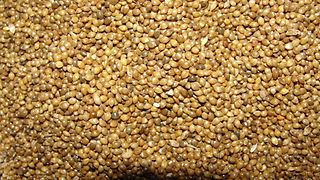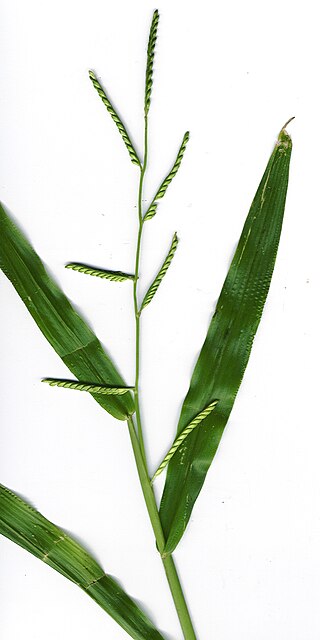
Millets are a highly varied group of small-seeded grasses, widely grown around the world as cereal crops or grains for fodder and human food. Most species generally referred to as millets belong to the tribe Paniceae, but some millets also belong to various other taxa.

Panicum miliaceum is a grain crop with many common names, including proso millet, broomcorn millet, common millet, hog millet, Kashfi millet, red millet, and white millet. Archaeobotanical evidence suggests millet was first domesticated about 10,000 BP in Northern China. Major cultivated areas include Northern China, Himachal Pradesh of India, Nepal, Russia, Ukraine, Belarus, the Middle East, Turkey, Romania, and the Great Plains states of the United States. About 500,000 acres are grown each year. The crop is notable both for its extremely short lifecycle, with some varieties producing grain only 60 days after planting, and its low water requirements, producing grain more efficiently per unit of moisture than any other grain species tested. The name "proso millet" comes from the pan-Slavic general and generic name for millet.

Eleusine coracana, or finger millet, also known as ragi in India, kodo in Nepal, and kurakkan in Sri Lanka, is an annual herbaceous plant widely grown as a cereal crop in the arid and semiarid areas in Africa and Asia. It is a tetraploid and self-pollinating species probably evolved from its wild relative Eleusine africana.

Pearl millet is the most widely grown type of millet. It has been grown in Africa and the Indian subcontinent since prehistoric times. The center of diversity, and suggested area of domestication, for the crop is in the Sahel zone of West Africa. Recent archaeobotanical research has confirmed the presence of domesticated pearl millet on the Sahel zone of northern Mali between 2500 and 2000 BC. 2023 is the International Year of Millets, declared by the United Nations General Assembly in 2021.

Foxtail millet, scientific name Setaria italica, is an annual grass grown for human food. It is the second-most widely planted species of millet, and the most grown millet species in Asia. The oldest evidence of foxtail millet cultivation was found along the ancient course of the Yellow River in Cishan, China, carbon dated to be from around 8,000 years before present. Foxtail millet has also been grown in India since antiquity.

Echinochloa frumentacea is a species of Echinochloa. Both Echinochloa frumentacea and E. esculenta are called Japanese millet. This millet is widely grown as a cereal in India, Pakistan, and Nepal. Its wild ancestor is the tropical grass Echinochloa colona, but the exact date or region of domestication is uncertain. It is cultivated on marginal lands where rice and other crops will not grow well. The grains are cooked in water, like rice, or boiled with milk and sugar. Sometimes it is fermented to make beer. While also being part of staple diet for some communities in India, these seeds are, in particular, eaten during religious fasting. For this reason, these seeds are commonly also referred to as "vrat ke chawal" in Hindi. Other common names to identify these seeds include oodalu (ಊದಲು) in Kannada, Shyamak (শ্যামাক) or Shyama Chal in Bangla, jhangora in the Garhwal Hills, bhagar (भगर) in Marathi-speaking areas, samo or morio seeds in Gujarati, or kuthiraivaali (குதிரைவாளி) in Tamil.

Echinochloa is a very widespread genus of plants in the grass family and tribe Paniceae. Some of the species are known by the common names barnyard grass or cockspur grass.

Echinochloa crus-galli is a type of wild grass originating from tropical Asia that was formerly classified as a type of panicum grass. It is commonly known as cockspur, barnyard millet, Japanese millet, water grass, common barnyard grass, or simply "barnyard grass". This plant can grow to 60" in height and has long, flat leaves which are often purplish at the base. Most stems are upright, but some will spread out over the ground. Stems are flattened at the base. The seed heads are a distinctive feature, often purplish, with large millet-like seeds in crowded spikelets.

Setaria is a widespread genus of plants in the grass family. The name is derived from the Latin word seta, meaning "bristle" or "hair", which refers to the bristly spikelets.
Heterodera sacchari, the sugarcane cyst nematode, mitotic parthenogenic sedentary endoparasitic nematode. This plant-parasitic nematode infects the roots of sugarcane, and the female nematode eventually becomes a thick-walled cyst filled with eggs. Aboveground symptoms are species specific and are similar to those caused by other Heterodera species. Symptoms include: stunted and chlorotic plants, and reduced root growth. Seedlings may be killed in heavily infested soils.

Digitaria sanguinalis is a species of grass known by several common names, including hairy crabgrass, hairy finger-grass, large crabgrass, crab finger grass, purple crabgrass. It is one of the better-known species of the genus Digitaria, and one that is known nearly worldwide as a common weed. It is used as animal fodder, and the seeds are edible and have been used as a grain in Germany and especially Poland, where it is sometimes cultivated. This has earned it the name Polish millet.

Paspalum scrobiculatum, commonly called Kodo millet or Koda millet, is an annual grain that is grown primarily in Nepal and also in India, Philippines, Indonesia, Vietnam, Thailand, and in West Africa from where it originated. It is grown as a minor crop in most of these areas, with the exception of the Deccan plateau in India where it is grown as a major food source. It is a very hardy crop that is drought tolerant and can survive on marginal soils where other crops may not survive, and can supply 450–900 kg of grain per hectare. Kodo millet has large potential to provide nourishing food to subsistence farmers in Africa and elsewhere.

Panicum sumatrense, known as little millet, is a species of millet in the family Poaceae.

Brachiaria, or signalgrass, is a genus of plants in the grass family native to tropical and subtropical regions of Asia, Africa, Australia, southern Europe, the Americas, and various islands. There are over 100 species.

Urochloa is a genus of plants in the grass family, native to Eurasia, Africa, Australia, Mexico, and the Pacific Islands. Common names include signalgrass.

Urochloa brizantha is a species of grass known by the common name palisade grass. It is often used as a forage for livestock.
Brachiaria deflexa is an annual millet grass belonging to the grass family (Poaceae). It is native to many regions such as Africa, India, and Pakistan in both tropical and subtropical regions. It has been used as a supplemental food source among other cereal crops.














